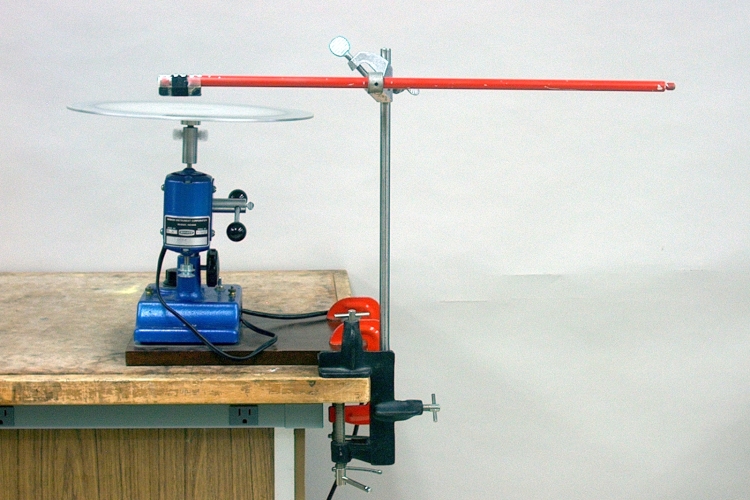
A magnet attached to the end of an aluminum swivel arm, rests on the edge of an aluminum disc. When the disc rotates, eddy currents induced in it by the magnet create a magnetic field that repels the magnet, which rises from the surface of the disc.
The apparatus in the photograph is a variable-speed motor, on whose shaft is mounted an aluminum disc. A magnet is fixed to the end of the red aluminum rod that extends over the disc, and when the disc is not rotating, the magnet rests on it. The magnet is polarized through its thickness, so that the top face is north and the bottom face is south. Thus, beneath the magnet, the magnetic field points upward through the disc. The motor turns counterclockwise, as viewed from the top, so when the disc is rotating, the front half moves from left to right. When you turn on the motor to start the disc rotating, in the area of the disc that lies underneath the magnet, the upward-pointing magnetic field induces an EMF that causes (positive) charges to flow radially outward, toward the edge of the disc. (Relative to the magnetic field, the charges in the disc are moving to the right, and with B pointing upward, they experience a force, F = qv × B, which points toward the front of the table.) The regions next to the ends of the magnets provide return paths for the outward-flowing charges, and this gives rise to two sets of currents, one at either end of the magnet. The one to the left of the magnet flows clockwise, and the one to the right of the magnet flows counterclockwise, as viewed from the top. Such currents, induced in en extended object (as opposed to a ring or a loop of wire) are called eddy currents. As the disc turns, the eddy currents on the right move away from the magnet, and the ones on the left move toward the magnet. These clockwise-flowing currents produce a magnetic field that points downward, opposing that of the magnet, which as noted above, points upward. As they move underneath the magnet, this magnetic field repels that of the magnet, and the magnet rises from the surface of the disc. We see this in the photograph, which shows the apparatus in operation.
Were the magnet sitting with its north face down, the charges moving under the magnet would flow radially inward, and the eddy currents would be in the reverse direction to those described above. Since B would now point downward, the upward-pointing magnetic field produced by the eddy currents approaching the magnet face would still oppose that of the magnet and lift the magnet off the disc. Similarly, if the disc rotated in the opposite direction, this would switch the directions in which the charges flowed, and the magnetic field produced by the currents approaching the magnet face would still repel the magnet and lift it off the disc.
References:
1) Sears, Francis Weston and Zemansky, Mark W. College Physics, Third Edition (Reading, Massachusetts: Addison-Wesley Publishing Company, 1960) p. 672-3.